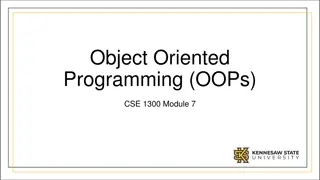Understanding Data Attributes and Types for Analysis
Exploring the concept of data attributes, this information covers attributes as properties of objects, the distinction between experimental and observational data, types of attributes like qualitative and quantitative, and the properties of attribute values. It also delves into examples and categorization of attributes based on distinctness, order, addition, and multiplication.
Download Presentation

Please find below an Image/Link to download the presentation.
The content on the website is provided AS IS for your information and personal use only. It may not be sold, licensed, or shared on other websites without obtaining consent from the author. Download presentation by click this link. If you encounter any issues during the download, it is possible that the publisher has removed the file from their server.
E N D
Presentation Transcript
What is Data? Attributes An attribute is a property or characteristic of an object Examples: eye color of a person, temperature, etc. Objects An Attribute is also known as variable, field, characteristic, or feature A collection of attributes describe an object An object is also known as record, point, case, sample, entity, instance, or observation
Experimental vs. Observational Data (Important but not in book) Experimental data describes data which was collected by someone who exercised strict control over all attributes. Observational data describes data which was collected with no such controls. Most all data used in data mining is observational data so be careful. Examples: -Distance from cell phone tower vs. childhood cancer -Carbon Dioxide in Atmosphere vs. Earth s Temperature
Types of Attributes: Qualitative vs. Quantitative (P. 26) Qualitative (or Categorical) attributes represent distinct categories rather than numbers. Mathematical operations such as addition and subtraction do not make sense. Examples: eye color, letter grade, IP address, zip code Quantitative (or Numeric) attributes are numbers and can be treated as such. Examples: weight, failures per hour, number of TVs, temperature
Types of Attributes (P. 25): All Qualitative (or Categorical) attributes are either Nominal or Ordinal. Nominal = categories with no order Ordinal = categories with a meaningful order All Quantitative (or Numeric) attributes are either Interval or Ratio. Interval = no true zero, division makes no sense Ratio = true zero exists, division makes sense division -> (increase %)
Types of Attributes: Some examples: Nominal ID numbers, eye color, zip codes Ordinal rankings (e.g., taste of potato chips on a scale from 1-10), grades, height in {tall, medium, short} Interval calendar dates, temperatures in Celsius or Fahrenheit, GRE score Ratio
Properties of Attribute Values The type of an attribute depends on which of the following properties it possesses: Distinctness: = Order: < > Addition: + - Multiplication: * / Nominal attribute: distinctness Ordinal attribute: distinctness & order Interval attribute: distinctness, order & addition Ratio attribute: all 4 properties
Discrete vs. Continuous (P. 28) Discrete Attribute Has only a finite or countably infinite set of values Examples: zip codes, counts, or the set of words in a collection of documents Note: binary attributes are a special case of discrete attributes which have only 2 values Continuous Attribute Has real numbers as attribute values Can compute as accurately as instruments allow Examples: temperature, height, or weight Practically, real values can only be measured and represented using a finite number of digits
Discrete vs. Continuous (P. 28) Qualitative (categorical) attributes are always discrete Quantitative (numeric) attributes can be either discrete or continuous
In class exercise #2: Classify the following attributes as discrete, or continuous. Also classify them as qualitative (nominal or ordinal) or quantitative (interval or ratio). Some cases may have more than one interpretation, so briefly indicate your reasoning if you think there may be some ambiguity. a) Number of telephones in your house b) Size of French Fries (Medium or Large or X-Large) c) Ownership of a cell phone d) Number of local phone calls you made in a month e) Length of longest phone call f) Length of your foot g) Price of your textbook h) Zip code i) Temperature in degrees Fahrenheit j) Temperature in degrees Celsius k) Temperature in Kelvin
UCSD Data Mining Competition Dataset E-commerce transaction anomaly data 19 attributes Each observation labeled as negative or positive for being an anomaly Download data from: http://sites.google.com/site/stats202/data/features.csv Read it into R > getwd() > setwd( C:/Documents And Settings/rajan/Desktop/ ) > data<-read.csv("features.csv", header=T) What are the first 5 rows? > data[1:5,] Which of the columns are qualitative and which are quantitative?
Types of Data in R R often distinguishes between qualitative (categorical) attributes and quantitative (numeric) In R, qualitative (categorical) = factor quantitative (numeric) = numeric
Types of Data in R For example, the state in the third column of features.csv is a factor > data[1:10,3] [1] CA CA CA NJ CA CA FL CA IA CA 53 Levels: AE AK AL AP AR AZ CA CO CT DC DE FL GA HI IA ID IL IN KS KY LA MA MD ME MI MN MO MS MT NC ... WY > is.factor(data[,3]) [1] TRUE > data[,3]+10 [1] NA NA NA NA NA NA NA NA Warning message: + not meaningful for factors
Types of Data in R The fourth column seems like some version of the zip code. It should be a factor (categorical) not numeric, but R doesn t know this. > is.factor(data[,4]) [1] FALSE Use as.factor to tell R that an attribute should be categorical > as.factor(data[1:10,4]) [1] 925 925 928 77 945 940 331 945 503 913 Levels: 77 331 503 913 925 928 940 945
Working with Data in R Creating Data: > aa<-c(1,10,12) > aa [1] 1 10 12 Some simple operations: > aa+10 [1] 11 20 22 > length(aa) [1] 3
Working with Data in R Creating More Data: > bb<-c(2,6,79) > my_data_set<-data.frame(attributeA=aa,attributeB=bb) > my_data_set attributeA attributeB 1 1 2 2 10 6 3 12 79
Working with Data in R Indexing Data: > my_data_set[,1] [1] 1 10 12 > my_data_set[1,] attributeA attributeB 1 1 2 > my_data_set[3,2] [1] 79 > my_data_set[1:2,] attributeA attributeB 1 1 2 2 10 6
Working with Data in R Indexing Data: > my_data_set[c(1,3),] attributeA attributeB 1 1 2 3 12 79 Arithmetic: > aa/bb [1] 0.5000000 1.6666667 0.1518987
Working with Data in R Summary Statistics: > mean(my_data_set[,1]) [1] 7.666667 > median(my_data_set[,1]) [1] 10 > sqrt(var(my_data_set[,1])) [1] 5.859465
Working with Data in R Writing Data: > setwd("C:/Documents and Settings/rajan/Desktop") > write.csv(my_data_set,"my_data_set_file.csv") Help!: > ?write.csv *
Sampling Sampling involves using only a random subset of the data for analysis Statisticians are interested in sampling because they often can not get all the data from a population of interest Data miners are interested in sampling because sometimes using all the data they have is too slow and unnecessary
Sampling The key principle for effective sampling is the following: using a sample will work almost as well as using the entire data sets, if the sample is representative a sample is representative if it has approximately the same property (of interest) as the original set of data
Sampling The simple random sample is the most common and basic type of sample In a simple random sample every item has the same probability of inclusion and every sample of the fixed size has the same probability of selection It is the standard names out of a hat It can be with replacement (=items can be chosen more than once) or without replacement (=items can be chosen only once) More complex schemes exist (examples: stratified sampling, cluster sampling)
Sampling in R: The function sample() is useful.
In class exercise #3: Explain how to use R to draw a sample of 10 observations with replacement from the first quantitative attribute in the data set http://sites.google.com/site/stats202/data/features.csv
In class exercise #3: Explain how to use R to draw a sample of 10 observations with replacement from the first quantitative attribute in the data set http://sites.google.com/site/stats202/data/features.csv Answer: > sam<-sample(seq(1,nrow(data)),10,replace=T) > my_sample<-data$amount[sam]
In class exercise #4: If you do the sampling in the previous exercise repeatedly, roughly how far is the mean of the sample from the mean of the whole column on average?
In class exercise #4: If you do the sampling in the previous exercise repeatedly, roughly how far is the mean of the sample from the mean of the whole column on average? Answer: about 3.6 > real_mean<-mean(data$amount) > store_diff<-rep(0,10000) > > for (k in 1:10000){ + sam<-sample(seq(1,nrow(data)),10,replace=T) + my_sample<-data$amount[sam] + store_diff[k]<-abs(mean(my_sample)-real_mean) + } > mean(store_diff) [1] 3.59541
In class exercise #5: If you change the sample size from 10 to 100, how does your answer to the previous question change?
In class exercise #5: If you change the sample size from 10 to 100, how does your answer to the previous question change? Answer: It becomes about 1.13 > real_mean<-mean(data$amount) > store_diff<-rep(0,10000) > > for (k in 1:10000){ + sam<-sample(seq(1,nrow(data)),100,replace=T) + my_sample<-data$amount[sam] + store_diff[k]<-abs(mean(my_sample)-real_mean) + } > mean(store_diff) [1] 1.128120
The square root sampling relationship: When you take samples, the differences between the sample values and the value using the entire data set scale as the square root of the sample size for many statistics such as the mean. For example, in the previous exercises we decreased our sampling error by a factor of the square root of 10 (=3.2) by increasing the sample size from 10 to 100 since 100/10=10. This can be observed by noting 3.6/1.13 is about 3.2. Note: It is only the sizes of the samples that matter, and not the size of the whole data set.
Sampling Sampling can be tricky or ineffective when the data has a more complex structure than simply independent observations. For example, here is a sample of words from a song. Most of the information is lost. oops I did it again I played with your heart got lost in the game oh baby baby oops! ...you think I m in love that I m sent from above I m not that innocent
Sampling Sampling can be tricky or ineffective when the data has a more complex structure than simply independent observations. For example, here is a sample of words from a song. Most of the information is lost. oops I did it again I played with your heart got lost in the game oh baby baby oops! ...you think I m in love that I m sent from above I m not that innocent























